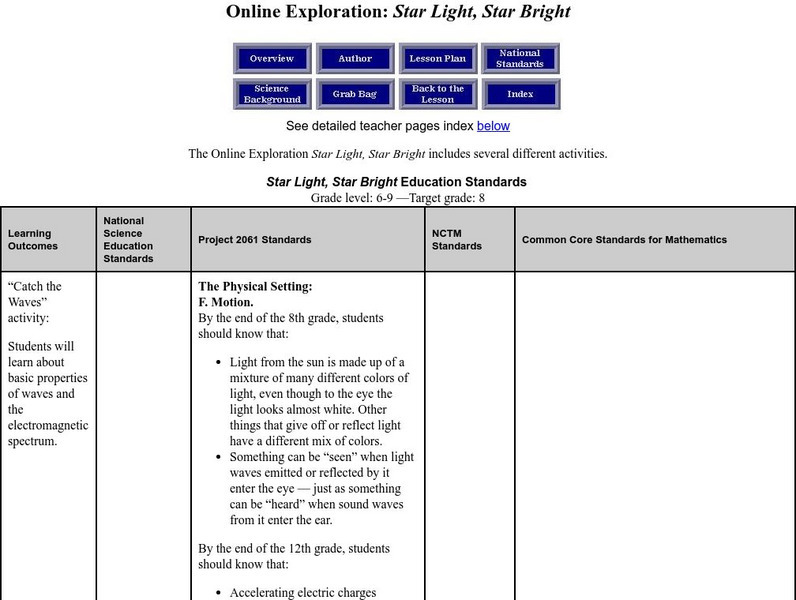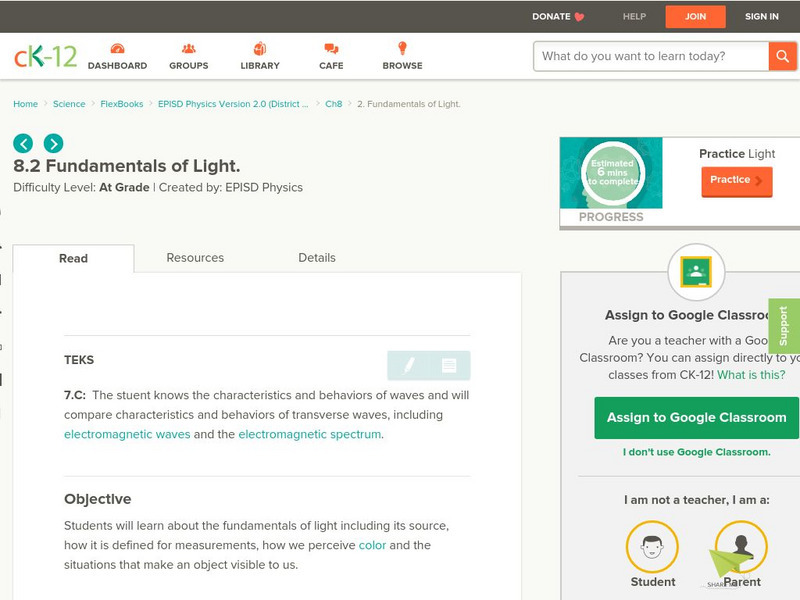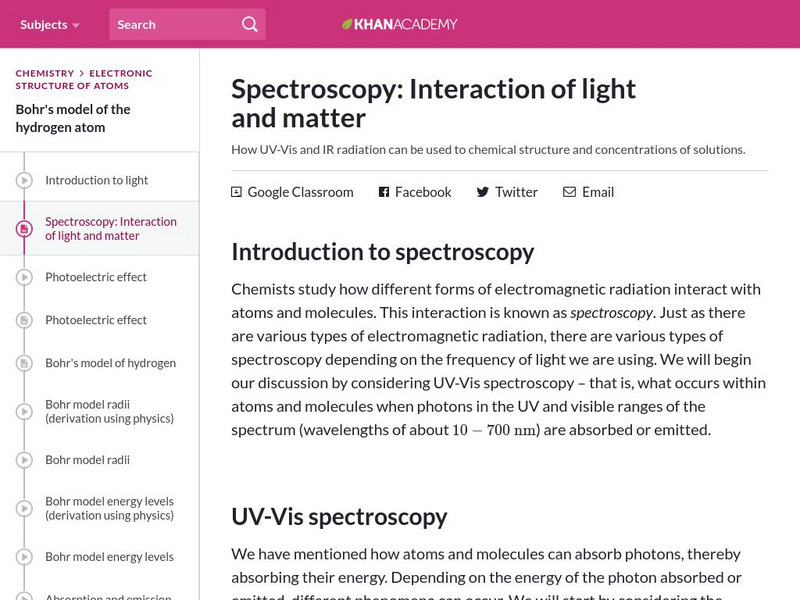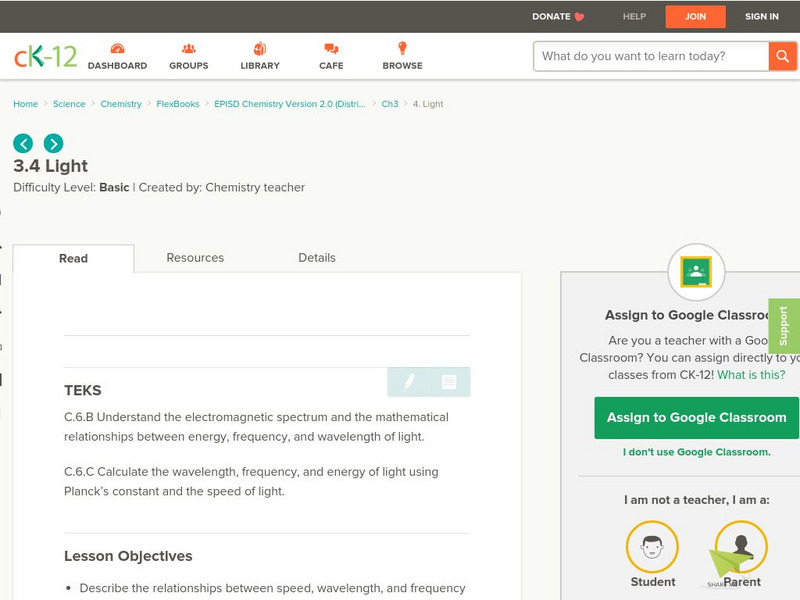Curated OER
Waves, Sound, and Light
Ninth graders explain waves in terms of energy transfer and describe their basic types and characteristics. They solve mathematical problems involving wavelength and frequency. Students conduct experiments in reflection and refraction.
Curated OER
How Far...How Powerful
Students explore the concept of gamma ray bursts. They examine basic physics concepts about light, measure the shifts of spectral lines, and utilize Hubble's Law to deduce the velocity of an astronomical object.
Georgia State University
Georgia State University: Hyper Physics: Scattering Concepts
A collection of several pages explaining the principles which underlie Rayleigh scattering of light.
PBS
Pbs Learning Media: Gamma Ray Burst Theories
This video segment from Swift: Eyes through Time introduces and explains theories of the origin of gamma-ray bursts. [4:11]
American Museum of Natural History
American Museum of Natural History: Ology: See the Light
Reflection, refraction, and the colors that make up white light is explored through lab activities after reading a brief background about light energy.
Space Telescope Science Institute
Amazing Space: Star Light, Star Bright
This online exploration provides an opportunity to identify the different properties of waves and the relationship that exists between energy, wavelength, and frequency. Correlate images from the Hubble Telescope to the wavelength,...
University of Colorado
University of Colorado: Physics 2000: More About Visualizing Electromagnetic Waves
Discusses the nature of an electromagnetic wave. Explains the oscillating electric field and represents it through clever graphics and animations.
University of Colorado
University of Colorado: Physics 2000: Cat Scans: Projecting Shadows
This page and the three pages which follow discuss how X-ray technology can be used to produce an image of the human body. Discussion is understandable and highly intriguing. Several interactive animations allow the visitor to explore...
University of Colorado
University of Colorado: Physics 2000: Speed of Light
Using an interesting and intriguing format, this page discusses the question of "How does one measure the speed of light." Explanation focuses on Galileo's and Roemer's efforts to obtain a reasonable value. Also discusses Heinrich...
PBS
Pbs Learning Media: What Is Albedo?
When light strikes an object it can cause reflection or absorption depending on the wavelength of the light and the property of the material that makes up the object. Watch this whiteboard animation for a full explanation and to find out...
University of Colorado
University of Colorado: Ph Et Interactive Simulations: Radiating Charge
An interactive simulation that teaches about electromagnetic radiation, dipole radiation, and electric fields by observing the effects of changes in sinusoidal, circular, and linear motion on the outward propagation of radiation. This...
PBS
Pbs: Cet: A Science Odyssey: Radio Transmission
In this illustrated tutorial, find out how radio signals get transmitted from an antennae to the air.
CK-12 Foundation
Ck 12: Fundamentals of Light
[Free Registration/Login may be required to access all resource tools.] Students investigate the fundamentals of light including its source, how it is defined for measurements, how we perceive color, and the situations that make an...
Khan Academy
Khan Academy: Spectroscopy: Interaction of Light and Matter
Tutorial provides a discussion of UV-Vis spectroscopy, infrared (IR) spectroscopy, and the Beer-Lambert law.
Nobel Media AB
The Nobel Prize: Arthur Holly Compton Biographical
In addition to overviewing Compton's (1892-1962 CE) studies in x-rays, this article includes information on Compton's published works, his education, and personal life.
Vision Learning
Visionlearning: Physics: Light Ii: Electromagnetism
Instructional module focusing on light and electromagnetism. Discussion includes historical discoveries that led to the understanding of the electromagnetic spectrum. Site also includes an interactive practice quiz and links relating to...
University of Colorado
University of Colorado: Physics 2000: Electromagnetic Waves
Using a student-teacher dialogue format, this page discusses the nature of light as an electromagnetic wave and the electromagnetic spectrum.
University of Colorado
University of Colorado: Physics 2000: Einstein's Legacy: X Rays
An explanation of how X-ray machines work. An online activity in which a comparison is made between how the hand would be viewed with X-ray versus with visible light. An additional page explains the use of X-rays in CAT scan devices.
California Institute of Technology
Nasa: Infrared Astronomy
A complete, multi-page tutorial on infrared radiation and its importance to astronomical studies.
Khan Academy
Khan Academy: Photoelectric Effect
Article explains the experiments on the photoelectric effect and how these experiments led to the idea of light behaving as a particle of energy called a photon.
NOAA
Noaa: Space Environment Topics: Radio Wave Propagation [Pdf]
NOAA has produced a series of topic papers for use by teachers and students. This paper is on the increase of radio wave activity and the effects solar emissions have on it. PDF format.
Art Institute of Chicago
The Art Institute of Chicago: Revealing Picasso
Using new technology related to examining artwork, The Art Institute of Chicago was able to uncover unknown details about one of Picasso's most famous works, "The Old Guitarist." Fascinating discoveries and technological processes make...
NASA
Nasa: Tour of the Electromagnetic Spectrum: Visible Light
Visible light waves are the only electromagnetic waves we can see. We see these waves as the colors of the rainbow. Each color has a different wavelength. Red has the longest wavelength and violet has the shortest wavelength. When all...
CK-12 Foundation
Ck 12: Light
[Free Registration/Login may be required to access all resource tools.] In the following tutorial students will describe the relationships between speed, wavelength, and frequency of light. They will understand the photoelectric effect...
















